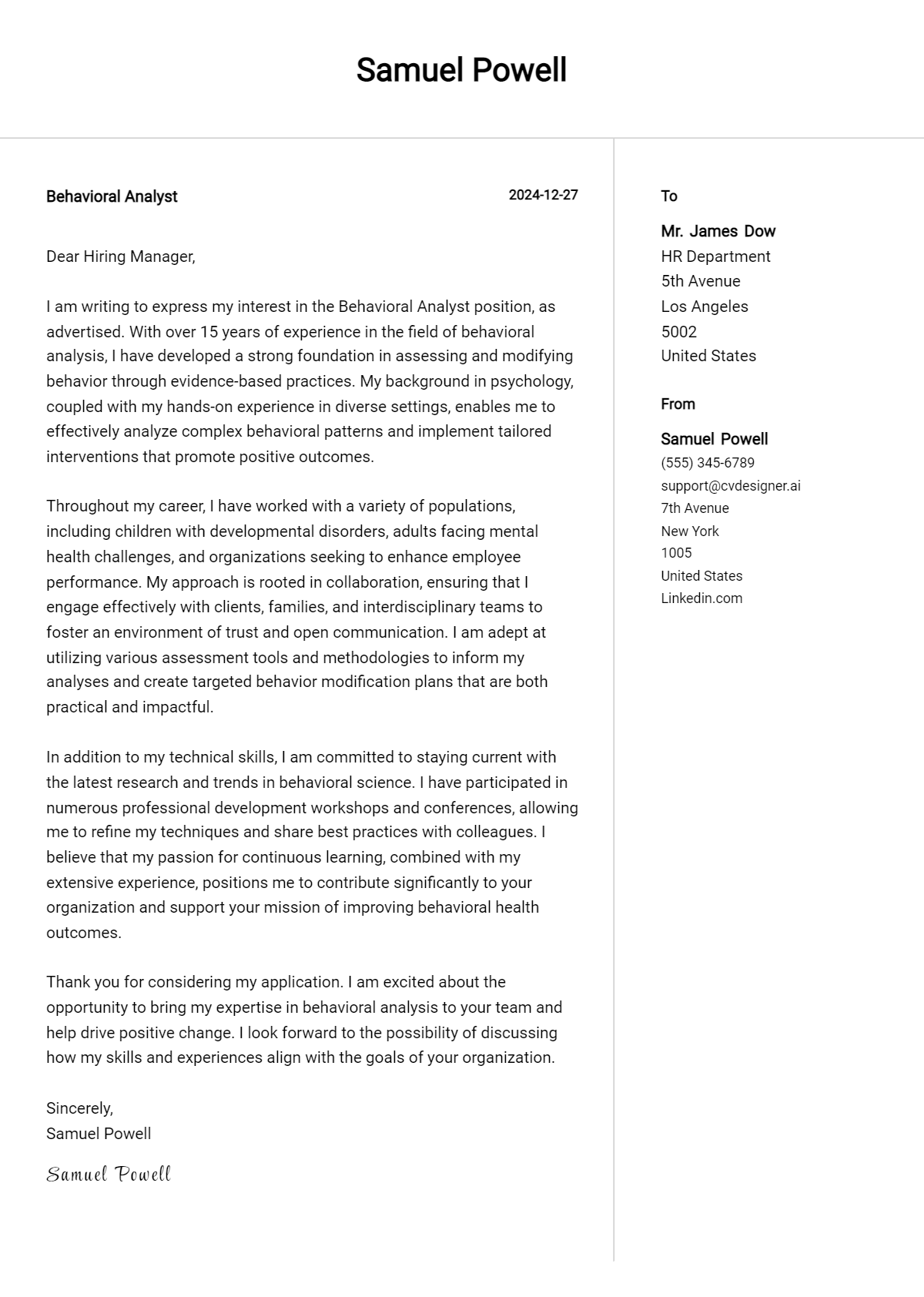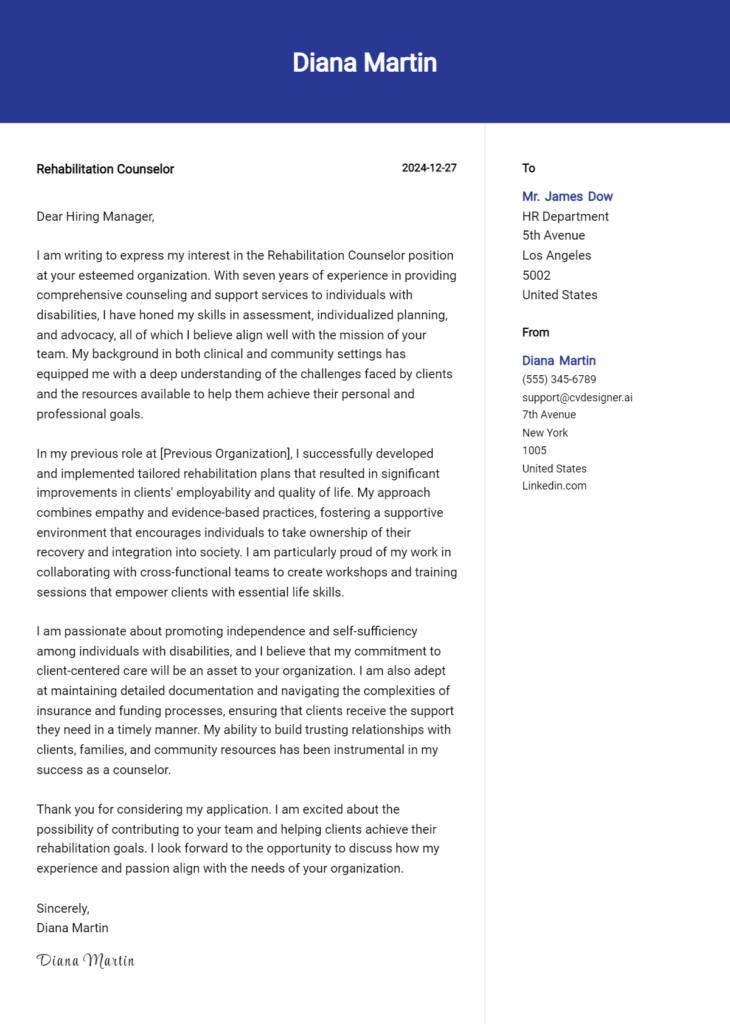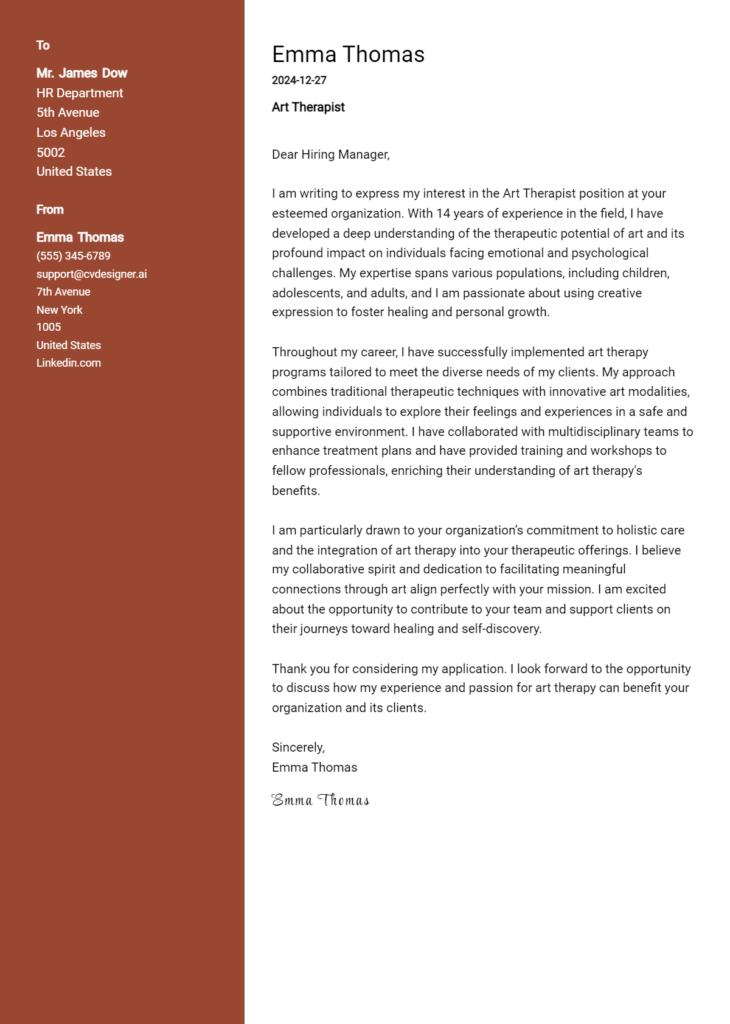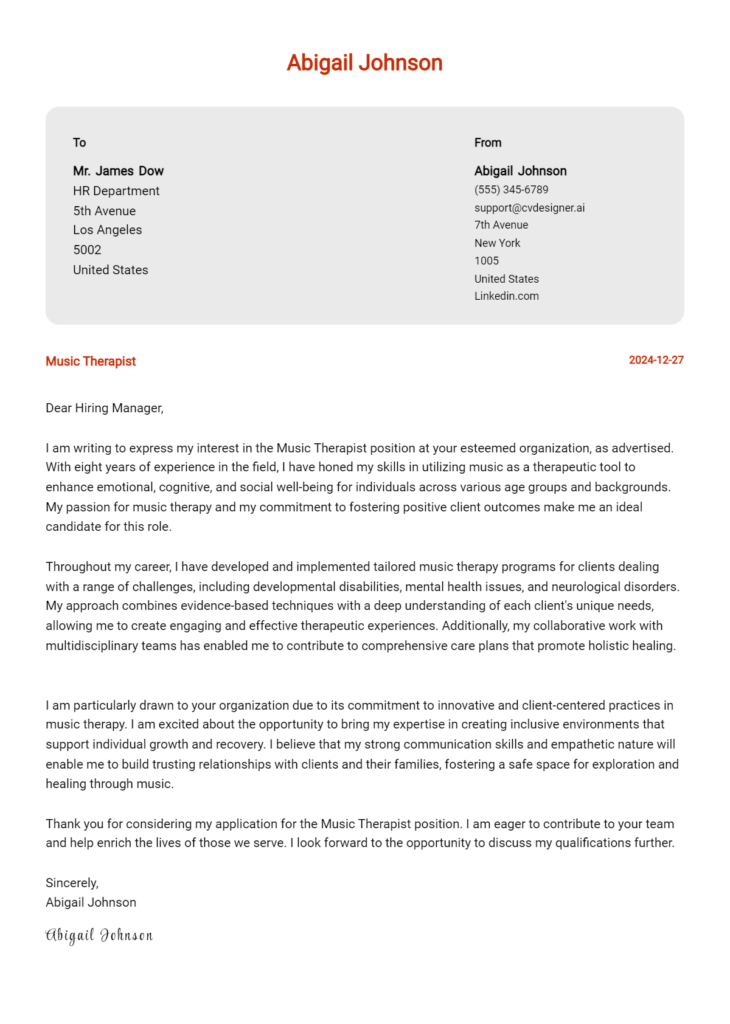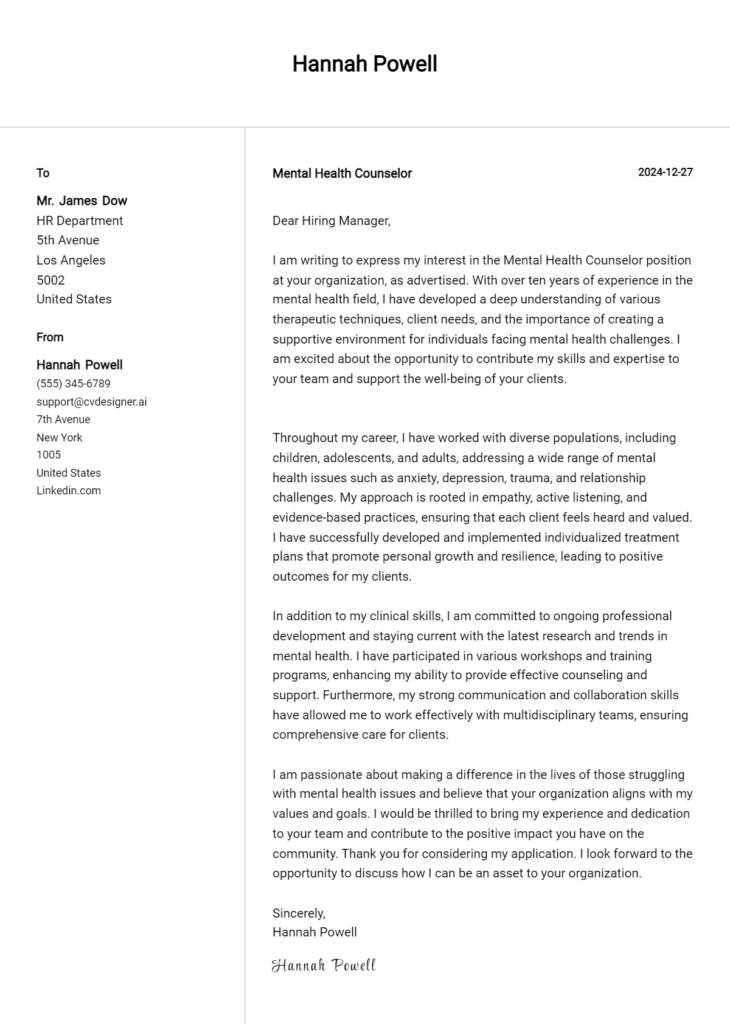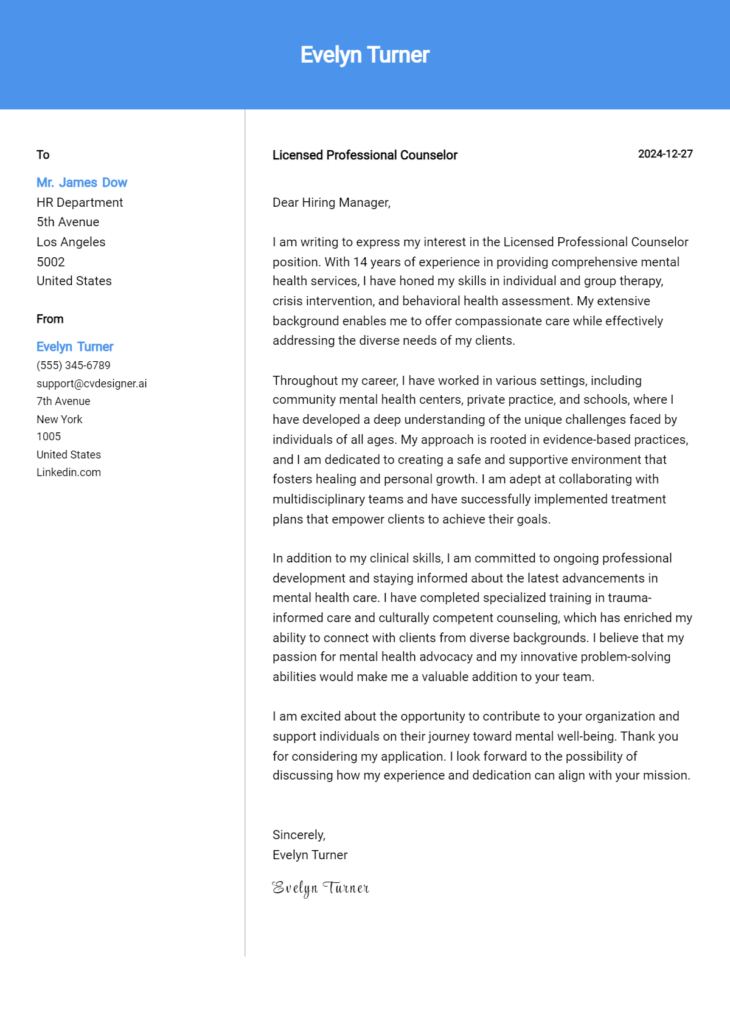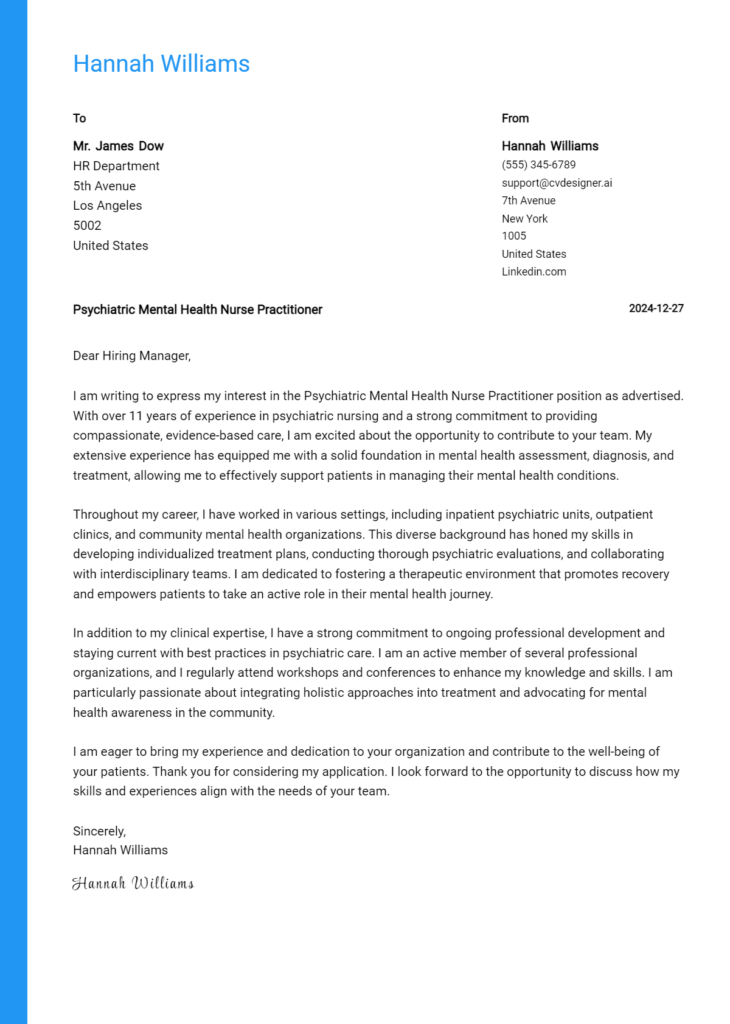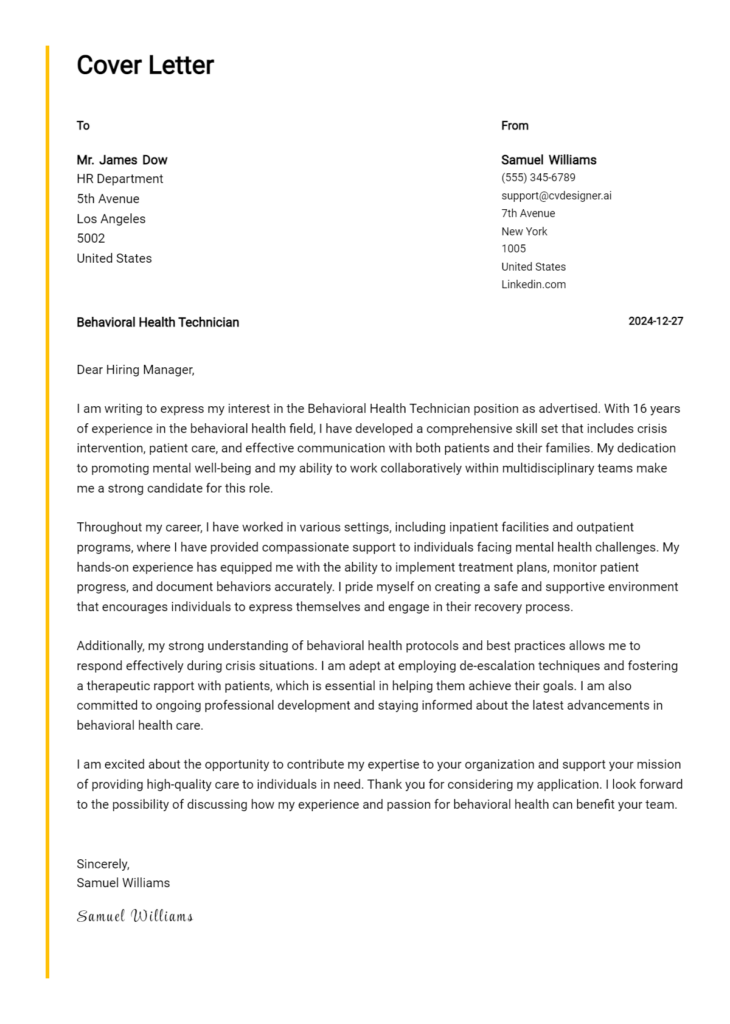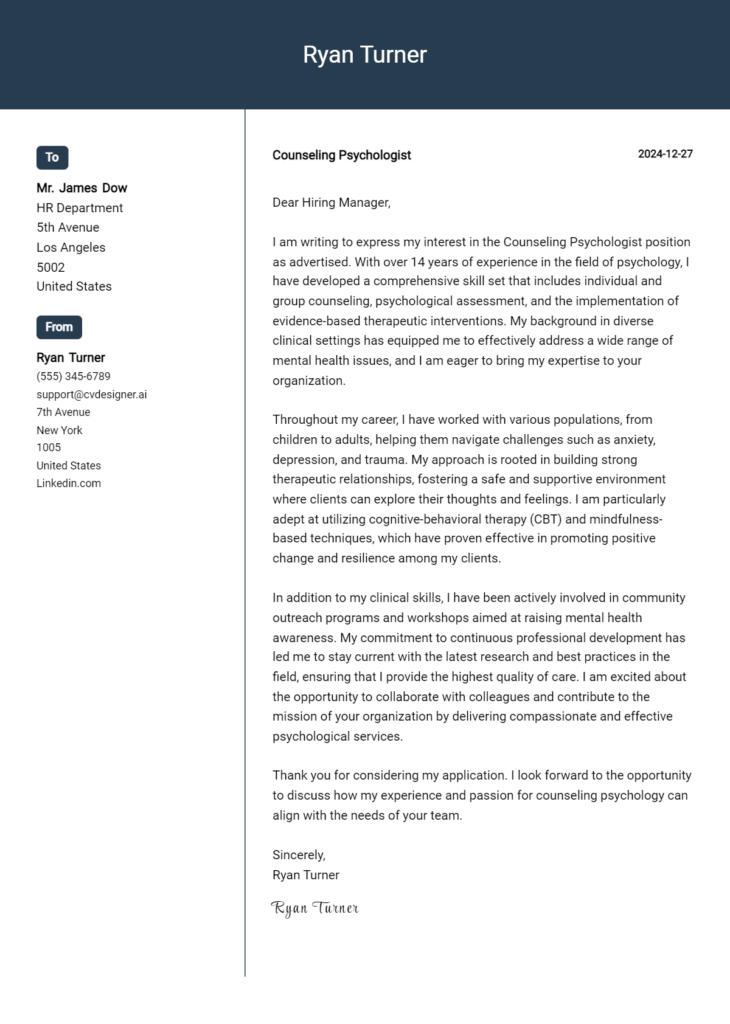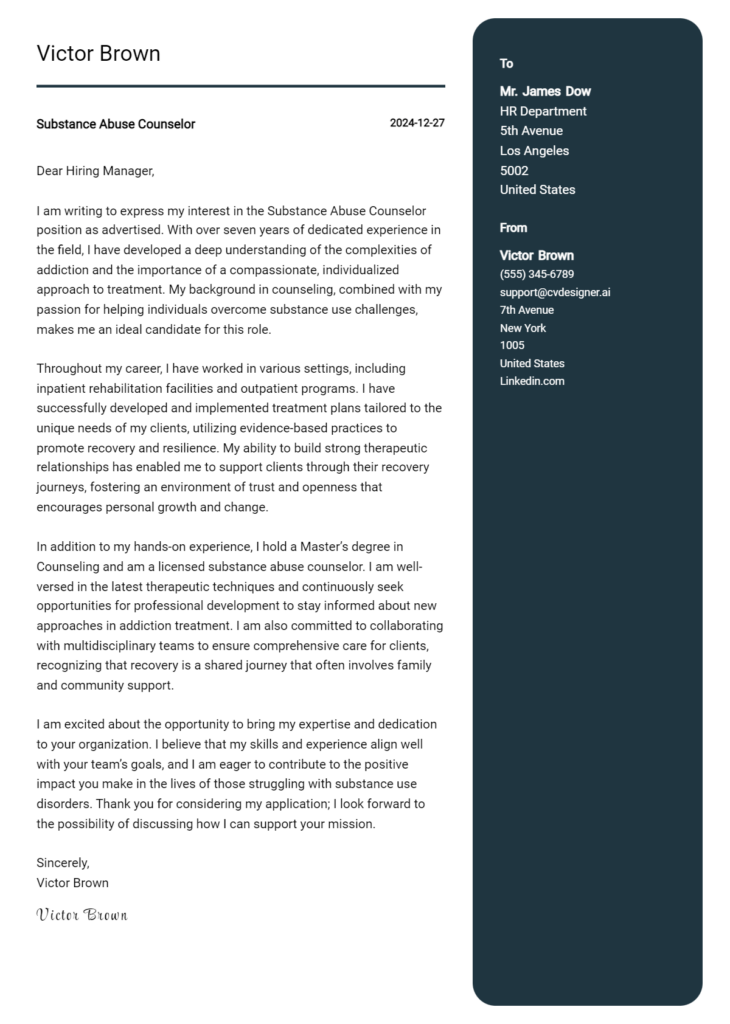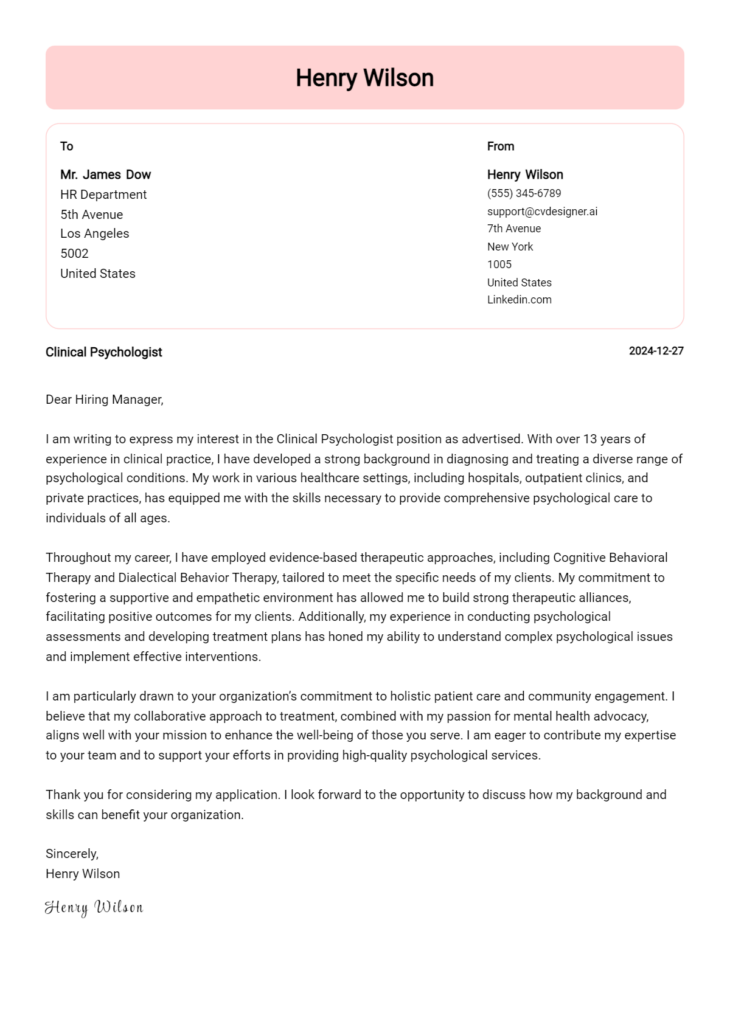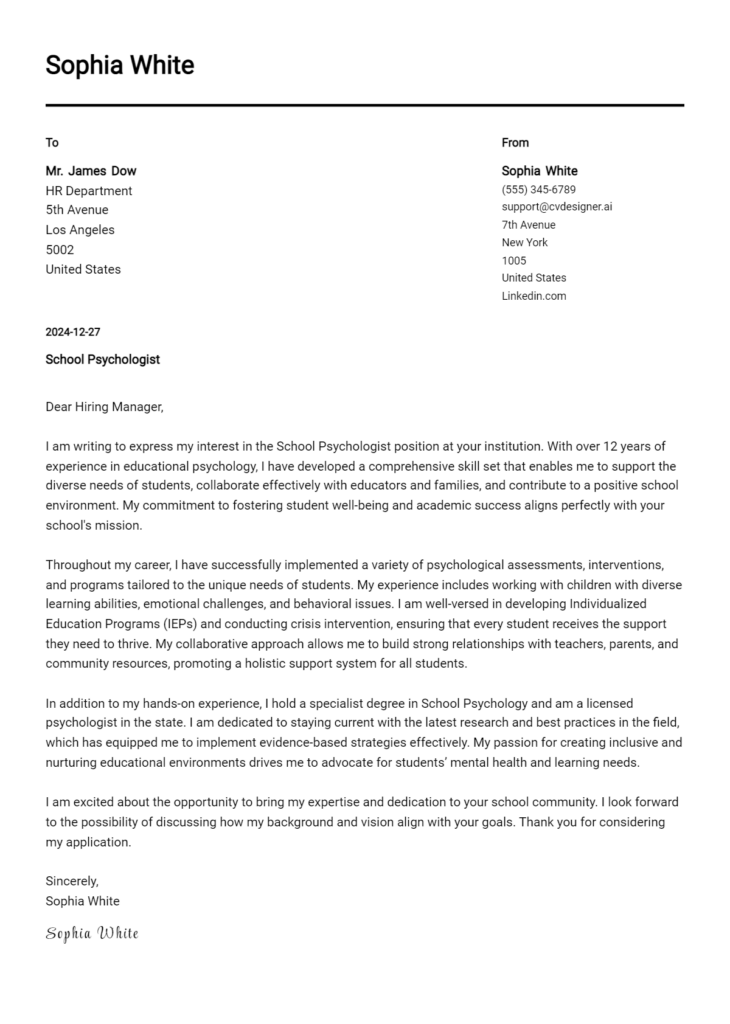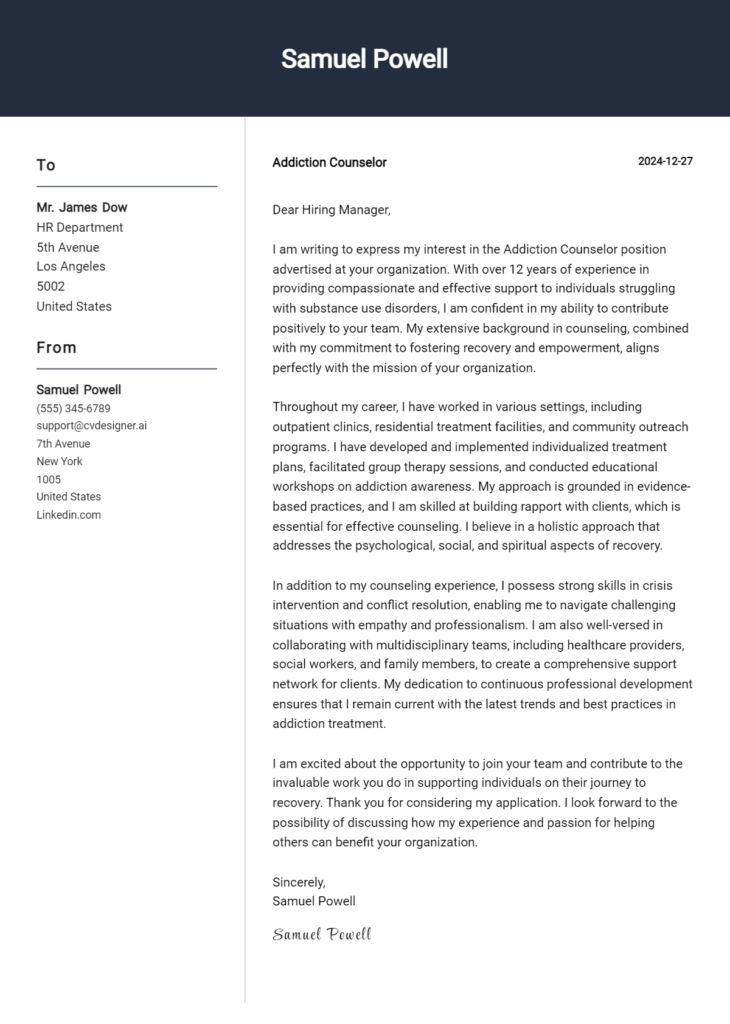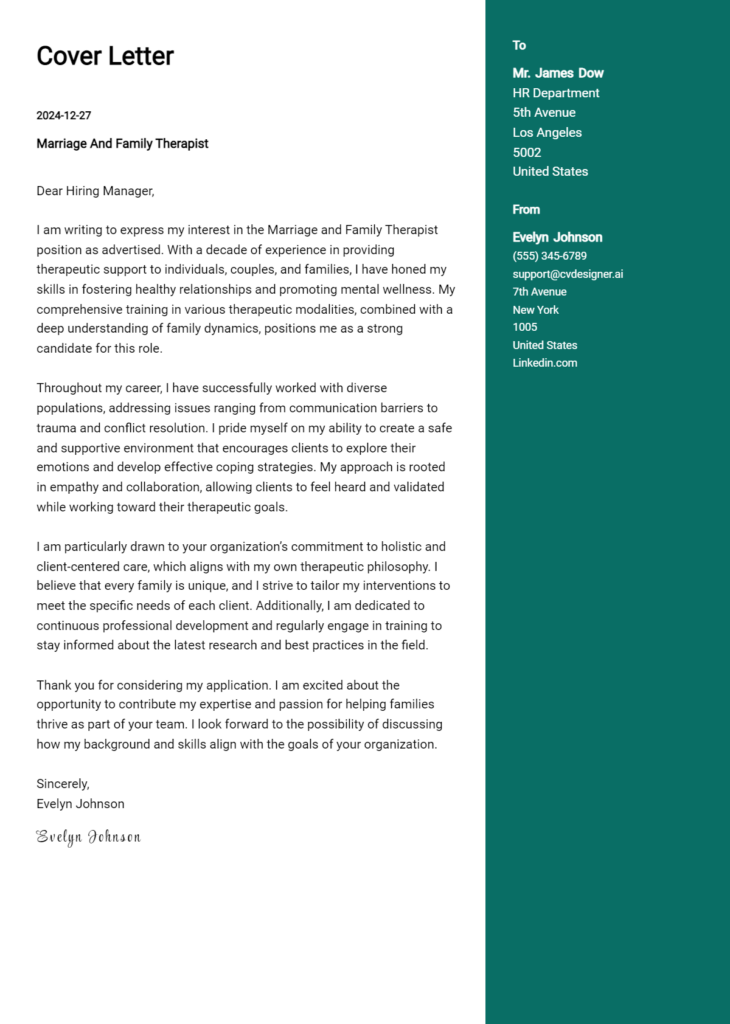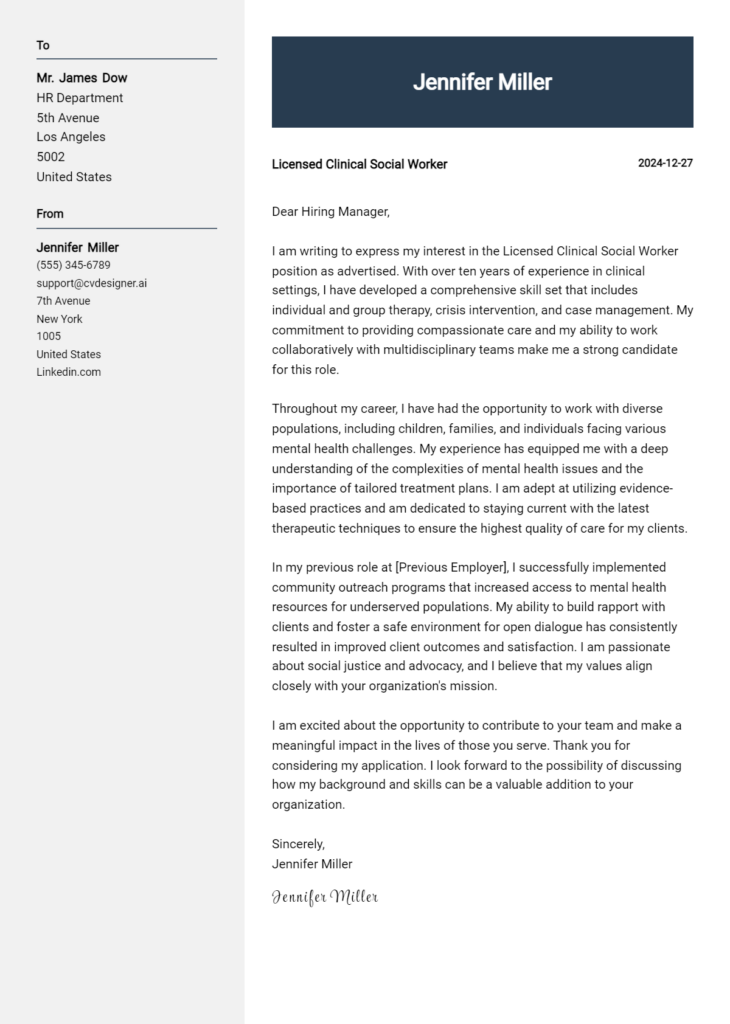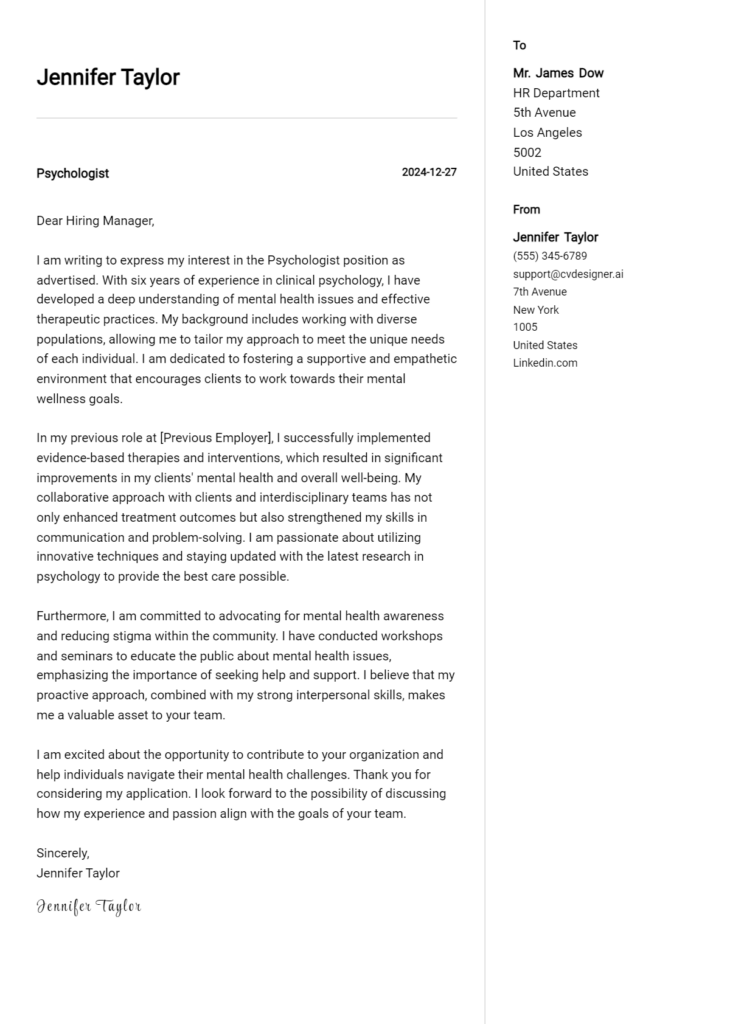Behavioral Analyst Cover Letter Examples
Explore additional Behavioral Analyst cover letter samples and guides and see what works for your level of experience or role.
How to Format a Behavioral Analyst Cover Letter?
Crafting a compelling cover letter is an essential step for Behavioral Analysts seeking to showcase their expertise and analytical skills. The format of your cover letter significantly influences the impression you make on hiring managers, reflecting your professionalism and attention to detail—critical attributes in the field of behavioral analysis. A well-structured cover letter not only captures the reader's attention but also effectively communicates your qualifications and suitability for the role.
In this guide, we will delve into the key components of a professional cover letter, providing insights and examples tailored for Behavioral Analysts.
We will focus on the essential elements of a successful cover letter, including:
- Cover Letter Header
- Cover Letter Greeting
- Cover Letter Introduction
- Cover Letter Body
- Cover Letter Closing
Each section serves a crucial purpose in highlighting your capabilities and commitment to the field. Let’s explore how to format each part to make your Behavioral Analyst cover letter stand out.
Importance of the Cover Letter Header for a Behavioral Analyst
The cover letter header is a crucial element in a job application, especially for a Behavioral Analyst, as it sets the tone for professionalism and clarity right from the start. This section should include your contact information, the date, and the recipient's details, ensuring that the hiring manager can easily reach you and identify the correspondence. A well-structured header conveys attention to detail and respect for the hiring process. A strong header not only enhances the overall presentation of your application but also provides essential information that facilitates effective communication.
Strong Example
John Doe 123 Main Street City, State, ZIP john.doe@email.com (123) 456-7890 October 16, 2023 Jane Smith Hiring Manager XYZ Behavioral Health 456 Elm Street City, State, ZIP
Weak Example
john doe email: johndoe@email.com 10/16/23 xyz behavioral health
The Importance of a Cover Letter Greeting for a Behavioral Analyst
The greeting of your cover letter is critical as it sets the tone for the entire document. A well-crafted greeting not only conveys professionalism but also demonstrates your effort to personalize your application. By addressing the hiring manager directly, you establish a connection and show that you are genuinely interested in the position. To make your greeting impactful, avoid generic terms like "To Whom It May Concern." Instead, take the time to research the recipient's name, which can often be found on the company's website or through professional networking platforms.
Here are examples of strong and weak greetings for a Behavioral Analyst cover letter:
Strong Greeting Example:
Dear Dr. Jane Smith,
Weak Greeting Example:
To Whom It May Concern,
The Importance of a Compelling Cover Letter Introduction for a Behavioral Analyst
A well-crafted cover letter introduction is crucial for a Behavioral Analyst, as it serves as the first impression a candidate makes on a hiring manager. This introduction should not only capture the reader's attention but also express genuine interest in the role while briefly showcasing key skills or achievements that set the candidate apart. A strong introduction can create an immediate connection with the hiring manager, making them more inclined to read further and consider the applicant for the position. Below are examples of both effective and ineffective cover letter introductions for a Behavioral Analyst role.
Strong Example
Dear [Hiring Manager's Name], As a dedicated Behavioral Analyst with over five years of experience in data-driven behavioral research and intervention strategies, I am excited to apply for the position at [Company Name]. My passion for understanding human behavior, combined with my expertise in statistical analysis and program evaluation, has enabled me to develop effective behavior modification plans that have significantly improved client outcomes. I am eager to bring my skills and insights to your team and contribute to the innovative work being done at [Company Name].
Weak Example
To whom it may concern, I am writing to apply for the Behavioral Analyst position. I think it sounds like a good job, and I have some experience in this field. I hope to discuss my qualifications further if you have time.
Purpose of the Cover Letter Body for a Behavioral Analyst
The cover letter body for a Behavioral Analyst plays a crucial role in presenting the candidate's qualifications and aligning them with the specific needs of the organization. It serves as an opportunity to highlight relevant skills and experiences that demonstrate the candidate's ability to analyze behavior patterns and develop effective interventions. By detailing specific projects or accomplishments, such as successful case studies or innovative research contributions, the candidate can effectively communicate their value to the company and how they can contribute to its goals. This section should not only convey the candidate's expertise but also their passion for behavioral analysis and commitment to making a positive impact within the organization.
Strong Example
In my previous role as a Behavioral Analyst at XYZ Corporation, I successfully led a project aimed at reducing employee turnover by implementing a behavior modification program. By analyzing data on employee engagement and satisfaction, I identified key areas for improvement and developed targeted interventions that resulted in a 30% decrease in turnover within six months. Additionally, I collaborated with management to create training modules that educated staff on effective communication techniques, further enhancing workplace dynamics. My ability to combine data analysis with practical solutions has consistently driven positive outcomes, and I am eager to bring this expertise to your team.
Weak Example
I have worked as a Behavioral Analyst for a few years and have some experience with various projects. I think I am a good fit for your company because I know how to analyze behavior. In my last job, I tried to help with employee engagement but didn’t see any significant changes. I believe I could learn a lot from your organization and contribute in some way.
The Importance of a Strong Cover Letter Closing for a Behavioral Analyst
A well-crafted cover letter closing is crucial for a Behavioral Analyst as it serves to summarize qualifications, reiterate enthusiasm for the role, and encourage the hiring manager to take the next steps. A strong closing can leave a lasting impression, effectively highlighting your fit for the position and prompting the employer to review your resume or schedule an interview. Conversely, a weak closing may not convey your suitability or eagerness, potentially diminishing your chances of moving forward in the hiring process.
Strong Example
Thank you for considering my application for the Behavioral Analyst position at [Company Name]. With my extensive background in behavioral assessment and my passion for applying data-driven strategies to improve client outcomes, I am excited about the opportunity to contribute to your team. I look forward to discussing how my skills align with the goals of [Company Name]. Please feel free to review my resume, and I hope to schedule a time to speak soon.
Weak Example
I hope you look at my resume. I think I'm good for this job. Let me know if you want to talk.
Crafting an effective cover letter for a Behavioral Analyst position is crucial in making a strong first impression. This document offers you the opportunity to showcase your technical skills, problem-solving abilities, familiarity with the Software Development Life Cycle (SDLC), teamwork experience, and passion for continuous learning. By incorporating these elements into your cover letter, you can demonstrate your suitability for the role and your commitment to the field. Below are five tips to help you create a compelling cover letter that captures the attention of hiring managers.
Tips for Writing a Cover Letter as a Behavioral Analyst
Highlight Your Technical Skills
As a Behavioral Analyst, it's important to showcase your technical skills relevant to data analysis, statistical software, and programming languages. Mention specific tools you are proficient in, such as R, Python, or SQL, and provide examples of how you have utilized these skills in past projects. This demonstrates your capability to analyze complex data and derive actionable insights.Emphasize Problem-Solving Abilities
Problem-solving is a core competency for Behavioral Analysts. Use your cover letter to describe a specific challenge you faced in a previous role and the steps you took to address it. Detail the processes you implemented and the outcomes achieved. This will illustrate your analytical thinking and ability to navigate complex problems effectively.Showcase Your Knowledge of SDLC
Understanding the Software Development Life Cycle is essential in many Behavioral Analyst roles, especially when working on projects that involve software solutions. Highlight your familiarity with different stages of the SDLC, such as planning, development, and testing. Discuss how your knowledge has contributed to successful project completions in your past experiences.Demonstrate Teamwork Experience
Behavioral Analysts often work as part of a multidisciplinary team. In your cover letter, share experiences that showcase your ability to collaborate effectively with others. Highlight instances where you contributed to team objectives, facilitated discussions, or resolved conflicts. This demonstrates your interpersonal skills and your ability to thrive in a team-oriented environment.Express Your Passion for Continuous Learning
The field of behavioral analysis is constantly evolving, so it's vital to convey your eagerness for continuous learning. Discuss any recent courses, certifications, or workshops you have completed that are relevant to the role. This not only shows your commitment to professional growth but also indicates that you stay updated on industry trends and best practices.
By following these tips and incorporating your unique experiences and skills, you can create a persuasive cover letter that stands out. For additional assistance, consider using cover letter templates or a cover letter builder to streamline the writing process.
Common Mistakes to Avoid in a Behavioral Analyst Cover Letter
Crafting a compelling cover letter is essential for standing out in the competitive field of behavioral analysis. Avoiding common pitfalls can significantly enhance your chances of success. Here are some frequent mistakes candidates make when writing their cover letters, along with tips on how to steer clear of them:
Generic Content: Failing to tailor your cover letter to the specific job can make it seem impersonal. Always customize your letter for each application by mentioning the company and role directly.
Neglecting to Showcase Relevant Skills: Many candidates overlook the importance of highlighting their specific behavioral analysis skills. Be sure to include relevant experience and competencies that align with the job description.
Poor Formatting: A cluttered or unprofessional layout can detract from your message. Follow a clear cover letter format to ensure your letter is easy to read.
Using Clichés: Phrases like "hard-working" or "team player" can weaken your cover letter. Opt for unique descriptions that illustrate your strengths with specific examples instead.
Focusing on Responsibilities Rather Than Achievements: Instead of listing job duties, emphasize your accomplishments and how they benefited your previous employers. Use quantifiable metrics where possible.
Ignoring the Employer's Needs: Failing to address how your skills meet the employer's needs can be a major oversight. Research the organization and demonstrate how you can contribute to their goals.
Typos and Grammatical Errors: Spelling and grammar mistakes can undermine your professionalism. Proofread thoroughly or ask someone else to review your letter before submission.
By steering clear of these common mistakes and focusing on creating a well-structured, customized letter, you can significantly improve your chances of landing an interview. For inspiration, check out various cover letter examples that showcase effective strategies.
Cover Letter FAQs for Behavioral Analyst
What should I include in my cover letter as a Behavioral Analyst?
In your cover letter, highlight your educational background, relevant experience, and specific skills related to behavioral analysis. Mention any certifications, such as Board Certified Behavior Analyst (BCBA), if applicable. Discuss your familiarity with behavioral assessment tools and techniques, as well as your experience in developing and implementing intervention strategies. Share examples of successful outcomes from your previous work, emphasizing your ability to collaborate with multidisciplinary teams. Lastly, express your passion for helping individuals improve their behaviors and overall quality of life, which is crucial for a role in this field.
How do I tailor my cover letter for a specific Behavioral Analyst position?
To tailor your cover letter, carefully read the job description and identify key skills and experiences the employer is seeking. Align your qualifications with these requirements by using specific examples from your past work. Mention the company's mission or values and explain how your background and interests fit with their goals. If the position involves working with a particular population, such as children with autism, emphasize your relevant experience and training in that area. Personalizing your cover letter shows that you have a genuine interest in the position and understand the unique aspects of the role.
How can I demonstrate my communication skills in my cover letter?
Communication skills are vital for a Behavioral Analyst, as you will regularly interact with clients, families, and other professionals. In your cover letter, provide examples of how you have effectively communicated behavioral strategies and interventions to clients and caregivers. Highlight experiences where you led training sessions, facilitated discussions, or wrote reports that contributed to a client's progress. You can also mention your ability to adapt your communication style based on the audience, ensuring that complex concepts are easily understood. Demonstrating these skills through specific anecdotes can make your application stand out.
Is it important to include specific examples in my cover letter?
Yes, including specific examples in your cover letter is essential. It not only provides evidence of your skills and experiences but also helps the hiring manager visualize your impact in previous roles. Use metrics or outcomes when possible, such as improvements in client behavior or successful implementation of treatment plans. Examples can illustrate your problem-solving abilities and showcase your critical thinking skills, which are important in behavioral analysis. Specifically, discussing a challenging case and the strategies you employed to achieve positive results can demonstrate your competence and readiness for the role.
Build your Cover Letter in minutes
Use an AI-powered cover letter builder and have your letter done in 5 minutes. Just select your template and our software will guide you through the process.

